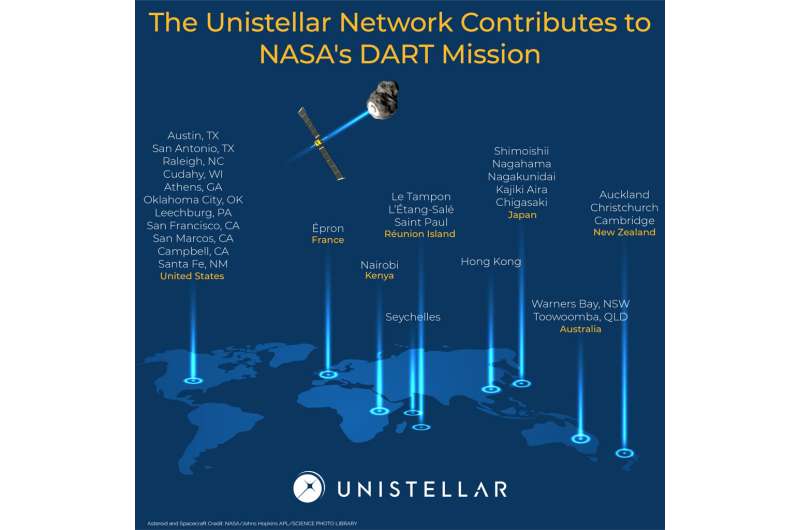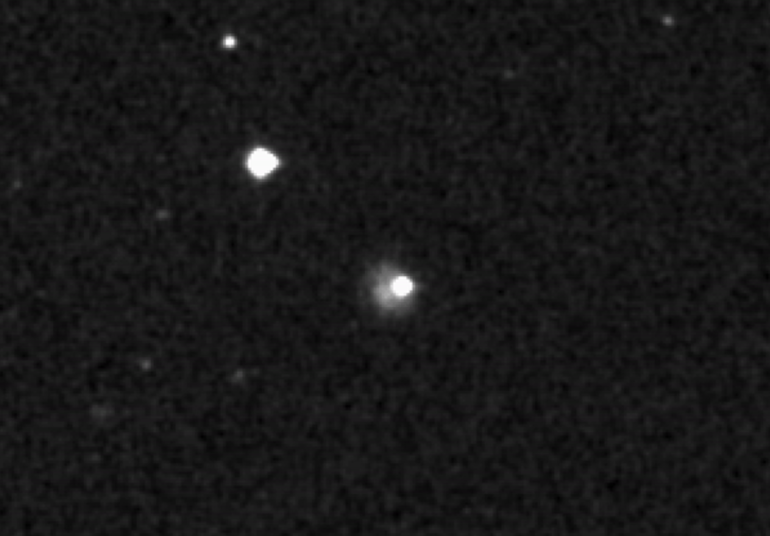Citizen scientists worldwide made decisive contributions to defend our planet by recording accurate and meaningful observations supporting the NASA DART (Double Asteroid Redirection Test) mission. The team, including eight SETI Institute astronomers and led by SETI Institute postdoctoral fellow Ariel Graykowski published their results in Nature on March 1.
NASA’s first test mission for planetary defense, DART, which seeks to test and validate a method to protect Earth in case of an asteroid strike, reached Dimorphos, a moon of the near-Earth asteroid Didymos on September 26, 2022. Unistellar citizen scientists were mobilized by SETI Institute researchers to observe the impact live, which was only visible from parts of Africa. Several observers in Kenya and Réunion Island successfully recorded the event with their smart telescope, witnessing the first successful deflection of an astronomical object using human technology.

© NASA/Johns Hopkins APL/Science Photo Library
Traveling telescope team
Thirty-one citizen scientists observed before and after the impact from multiple countries around the world.
From ground-based observations of the impact, the Unistellar Network captured the sudden brightening by a factor of 10 of the Didymos system due to the ejecta produced when the spacecraft hit Dimorphos. Graykowski used her expertise in cometary activity to analyze the impact ejecta and estimate its mass, speed, and energy.
These analyses resulted in an estimated momentum enhancement factor similar to that reported by NASA’s DART team. Additionally, The Unistellar telescope network was able to measure a change in color at the time of impact thanks to the critical timing of these observations. This ephemeral color change remains unexplained.
“The timing of observations during the DART impact and the continued monitoring of Didymos afterward was absolutely crucial to analyze the impact’s effects on Dimorphos. The Unistellar Network was the perfect tool to do just that,” said Graykowski, who is part of a team of SETI Institute researchers guided by Franck Marchis, a senior astronomer at the SETI Institute and Chief Science Officer and co-founder at Unistellar.
“Our citizen astronomers were excited to witness with their Unistellar telescopes the impact of DART, the first ever attempt to divert an asteroid. It’s commendable that we are the only group that has reported a scientific analysis of the impact, showing the ejecta cloud and the aftermath for a month. There is always a clear starry night somewhere in the Unistellar network, and that’s without doubt the strength of our network; we can see any part of the sky at any time,” said Marchis.
The paper led by Graykowski was published in Nature along with four others describing the aftermath of the impact and confirming the deflection of the moon of Didymos. This publication stands out due to the involvement of citizen science as the driving force behind the study, including four observations taken at the time of impact.
All the 31 citizen scientists of the Unistellar network involved in this study are co-authors of this scientific paper. Four of them (Patrice Huet, Matthieu Limagne, Bruno Payet from Réunion Island, and the Traveling telescope team in Kenya) observed the impact. Eight scientists from the SETI Institute (Ariel Graykowski, Ryan Lambert, Franck Marchis, Dorian Cazeneuve, Paul Dalba, Thomas Esposito, Daniel Peluso, and Lauren Sgro) have contributed to this research.
More information:
Ariel Graykowski et al, Light Curves and Colors of the Ejecta from Dimorphos after the DART Impact, Nature (2023). DOI: 10.1038/s41586-023-05852-9
Citation:
Unistellar citizen science network and SETI Institute contribute to planetary defense (2023, March 2)
